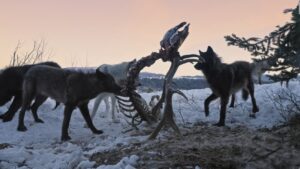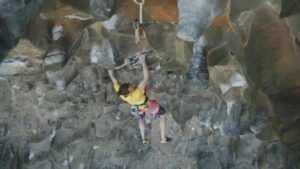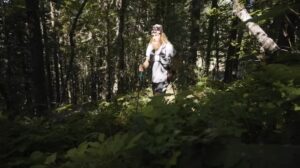In 1937, France considered wolves locally extinct. Yet in 2021, the population numbers an estimated 600. Perhaps cross-border migration helped flip the numbers, or perhaps the species evaded detection for years.
In this week’s Weekend Warm-up, a team of snow riders and environmentalists track France’s wolves and discover that they roam surprisingly close to humans.

A wolf’s sense of smell is 100 times more powerful than a human’s.
An elusive predator
At the end of the 18th century, thousands of wolves lived in France. But they were unpopular. Locals thought they were a threat and hunted them to local extinction. Lynx in France suffered a similar fate.
Despite hunting in packs of up to 30, wolves can be tricky to find. Often, it is only their howl (used to communicate with their pack) that locates them. Wolves can run at speeds of more than 60kph. With more than 40 teeth, they can devour up to 10kg of meat in one meal. Large hoofed mammals like bison, moose, and deer are their preferred prey. Their keen sense of smell, which is more than 100 times more powerful than humans, helps them remain relatively invisible.
Today, killing wolves is illegal in France. The wolf population is rising, which means that wolves and humans will have to coexist.
Tracking wolves
Thomas Delfino is a snow enthusiast who spends his winter days skiing untouched snow. He shares his recreational territory with many wild animals but rarely sees them.
“I knew nothing of the wild world in which I would ride almost every day in winter,” Delfino explains. Working with Pierre Sellier, Lionel Tassan, and Guillaume Collombet, he now seeks a better understanding of his wild neighbors.
Tassen is a wildlife photographer who specializes in mountain environments. His image collection includesowls, wolves, and other alpine species in their natural habitat.

A fresh footprint.
By tracking footprints, Tassen learns where wolves roam. When the footprints are sharp, he knows that they are fresh. Once he understands where the wolves move, he sets up camera traps.
The camera traps have provided plenty of great footage. One video shows a wolf carrying a severed deer head in broad daylight. When the animal nears the camera, it smells that humans have been close by and turns in the opposite direction.
Leaving no trace has become a common turn of phrase. Humans should strive to co-exist with nature, without spoiling it. Wolves have come close to mastering that. They coexist with humans and remain largely undetected.






